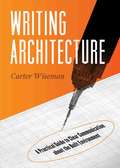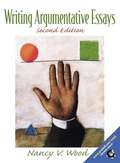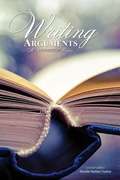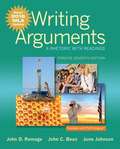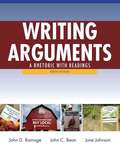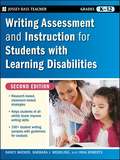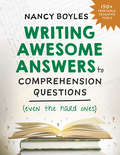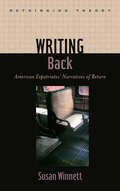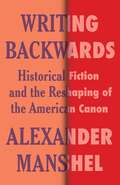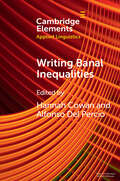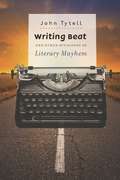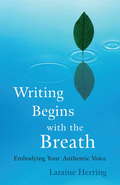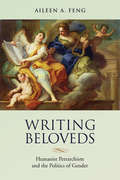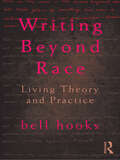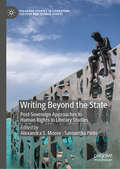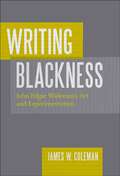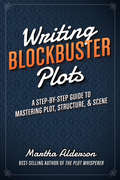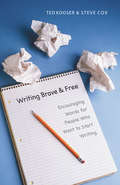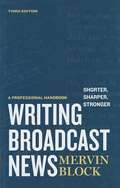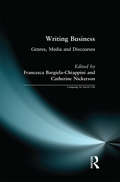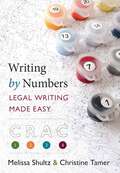- Table View
- List View
Writing Architecture
by Carter WisemanFor ages, architects have been criticized for speaking an insular language, known to some as "archispeak." Writing Architecture considers the process, methods, and value of architecture writing based on Carter Wiseman's 30 years of personal experience in writing, editing, and teaching in young architects how to write. This book creatively tackles a problematic issue that Wiseman considers to be a crucial characteristic of successful architecture writing: clarity of thinking and expression. He argues that because we live our lives within the built environment, architecture is the most comprehensive and complex of all art forms. Even brilliantly inspired and complex architectural structures would only amount to misunderstood abstractions without the support and reinforcement of the clear explanation.Written as a primer for both college level students and practitioners, Writing Architecture acknowledges and explores the boundaries between different techniques of architecture writing from myriad perspectives and purposes. A poetic description of the beauty and impact of a bridge will not illuminate the mechanical knowledge housed in the structure, but at the same time, dense architectural theory will not encourage individuals experiencing and supporting the bridge to perceive significance and usefulness in the design. Using excerpts and from writers in different genres and from different historical periods, Wiseman offers a unique and authoritative perspective on comprehensible writing skills needed for success.
Writing Architecture
by Carter WisemanFor ages, architects have been criticized for speaking an insular language, known to some as "archispeak." Writing Architecture considers the process, methods, and value of architecture writing based on Carter Wiseman's 30 years of personal experience in writing, editing, and teaching in young architects how to write. This book creatively tackles a problematic issue that Wiseman considers to be a crucial characteristic of successful architecture writing: clarity of thinking and expression. He argues that because we live our lives within the built environment, architecture is the most comprehensive and complex of all art forms. Even brilliantly inspired and complex architectural structures would only amount to misunderstood abstractions without the support and reinforcement of the clear explanation.Written as a primer for both college level students and practitioners, Writing Architecture acknowledges and explores the boundaries between different techniques of architecture writing from myriad perspectives and purposes. A poetic description of the beauty and impact of a bridge will not illuminate the mechanical knowledge housed in the structure, but at the same time, dense architectural theory will not encourage individuals experiencing and supporting the bridge to perceive significance and usefulness in the design. Using excerpts and from writers in different genres and from different historical periods, Wiseman offers a unique and authoritative perspective on comprehensible writing skills needed for success.
Writing Argumentative Essays (Second Edition)
by Nancy V. WoodThis unique rhetoric/reader helps readers develop strategies for critical reading, critical thinking, research, and writing that will help them argue clearly and convincingly in all types of argument. It shows how to identify and develop arguments, read and form reactions and opinions, analyze an audience, seek common ground, and use a wide, realistic range of techniques to write argument papers that express their individual views and original perspectives on modern issues. <P><P> Includes clear explanations and examples of argument theory and reading and writing processes, research and documentation skills, and offers a variety of writing activities for developing the exploratory paper, position paper, researched position paper, and the Rogerian argument paper. Unique chapters discuss argument styles (including cross-gender and cross-cultural communication styles), Rogerian argument, and argument and literature. 49 Essays for Analysis (several in each chapter) cover several broad issue areas and sub-issues concerning families, education, crime and the treatment of criminals, computers, race and culture in America, genetic engineering, and social responsibility.
Writing Arguments: A Rhetoric And Reader
by Brenda Herbert HarkerA reading companion for both the teachers and the students as they pursue the argumentative writing course; equipped with essays with different styles selected for viewpoint and meaning.
Writing Arguments: A Rhetoric With Readings
by John D. Ramage John C. Bean June JohnsonTeach students to read arguments critically and to produce effective arguments. Writing Arguments: A Rhetoric with Readings, Concise Edition, Seventh Edition integrates four different approaches to argument: the enthymeme as a logical structure, the classical concepts of logos, pathos, and ethos, the Toulmin system, and stasis theory. Focusing on argument as dialogue in search of solutions instead of a pro-con debate with winners and losers, it is consistently praised for teaching the critical-thinking skills needed for writing arguments. Major assignment chapters each focus on one or two classical stases (e.g. definition, resemblance, causal, evaluation, and policy). Each concept is immediately reinforced with discussion prompts, and each chapter ends with multiple comprehensive writing assignments.
Writing Arguments: A Rhetoric with Readings, Ninth Edition
by John D. Ramage June Johnson John C BeanThe market-leading guide to arguments, Writing Arguments ,9/e has proven highly successful in teaching readers to read arguments critically and to produce effective arguments of their own.
Writing Assessment and Instruction for Students with Learning Disabilities
by Nancy Mather Barbara J. Wendling Rhia RobertsIt Contains strategies for working with all students that struggle with writing, Offers classroom-tested strategies, helpful information, 100+writing samples with guidelines for analysis, and handy progress-monitoring charts, Includes ideas for motivating reluctant writers, Mather is an expert in the field of learning disabilities.
Writing Awesome Answers to Comprehension Questions (Even the Hard Ones)
by Nancy BoylesHelp students appreciate texts and write about them with conviction. Responding to a comprehension question is a surprisingly complex task. It draws on multiple skills: students must be able to read and analyze a text passage; consider what aspect of the text the question addresses; and then quickly and concisely write about their ideas, citing evidence to support them. Hence the prominence of constructed-response questions in standardized testing. In this refreshingly clear and upbeat guide, literacy consultant Nancy Boyles gives a step-by-step demonstration of how to help students achieve success with this task—and in the process of unpacking the steps involved, demonstrates how the instruction can inspire teachers’ creativity as well as deepen students’ literacy skills. Filled with ready-to-use scaffolds for every stage of instruction—sets of sample questions, anchor charts, cue cards, answer frames—this is a one-stop resource for teaching students how to organize their thoughts about what they’ve read, and then set them down in writing.
Writing Back: American Expatriates' Narratives of Return (Rethinking Theory)
by Susan WinnettExplore the shock of the new—and the familiar—experienced by well-known expatriate writers when they returned to the United States.The migration of American artists and intellectuals to Europe in the early twentieth century has been amply documented and studied, but few scholars have examined the aftermath of their return home. Writing Back focuses on the memoirs of modernist writers and intellectuals who struggled with their return to America after years of living abroad.Susan Winnett establishes repatriation as related to but significantly different from travel and exile. She engages in close readings of several writers-in-exile, including Henry James, Harold Stearns, Malcolm Cowley, and Gertrude Stein.Writing Back examines how repatriation unsettles the self-construction of the "returning absentee" by challenging the fictions of national and cultural identity with which the writer has experimented during the time abroad. As both Americans and expatriates, these writers gained a unique perspective on American culture, particularly in terms of gender roles, national identity, artistic self-conception, mobility, and global culture.
Writing Backwards: Historical Fiction and the Reshaping of the American Canon (Literature Now)
by Alexander ManshelContemporary fiction has never been less contemporary. Midcentury writers tended to set their works in their own moment, but for the last several decades critical acclaim and attention have fixated on historical fiction. This shift is particularly dramatic for writers of color. Even as the literary canon has become more diverse, cultural institutions have celebrated Black, Asian American, Latinx, and Indigenous novelists almost exclusively for their historical fiction.Writing Backwards explores what the dominance of historical fiction in the contemporary canon reveals about American literary culture. Alexander Manshel investigates the most celebrated historical genres—contemporary narratives of slavery, the World War II novel, the multigenerational family saga, immigrant fiction, and the novel of recent history—alongside the literary and academic institutions that have elevated them. He examines novels by writers including Toni Morrison, Viet Thanh Nguyen, Colson Whitehead, Julia Alvarez, Leslie Marmon Silko, Michael Chabon, Julie Otsuka, Yaa Gyasi, Ben Lerner, and Tommy Orange in the context of MFA programs, literary prizes, university syllabi, book clubs, and the National Endowment for the Arts. Manshel studies how historical fiction has evolved over the last half century, documenting the formation of the newly inclusive literary canon as well as who and what it still excludes. Offering new insight into how institutions shape literature and the limits of historical memory, Writing Backwards also considers recent challenges to the historical turn in American fiction.
Writing Banal Inequalities: How to Fabricate Stories Which Disrupt (Elements in Applied Linguistics)
by Alfonso Del Percio Hannah CowanIn this Element, the authors write about the everyday production and experiences of banal inequality. Through a series of sections, each comprising of a blogpost written for Disruptive Inequalities, and a commentary from the author on the predicaments they encountered in the writing process, this Element shares, and confronts, the ways we fabricate stories and use writing to resist. It makes visible the choices, practices, and reflections that have led to the writing of our stories and offers the tools we have used to fabricate them, to all those who may find them meaningful to appropriate, adapt, and translate to fight the struggles that they want to fight. These tools are formulated in a way for writers to develop their own methods of storytelling and activism. The authors hope this Element contributes to an ongoing debate on how writing serves banal resistance.
Writing Beat and Other Occasions of Literary Mayhem
by John TytellThe story and history of the Beats couldn't be found in the traditional libraries or archives of academic research. For preeminent historian of Beat culture John Tytell, it had to be found in the bars, towns, roads, and hangouts of these writers and figures. And as Writing Beat demonstrates, the same techniques apply to new and future writers.Approaching the history of post-war twentieth century American literature, and in particular the Beat literary movement of Kerouac, Ginsberg, Burroughs, and others, Tytell finds himself uniquely positioned as an eyewitness to many of these stories. In this book, he shares his insight with the reader. As he interviewed, drank, traveled, and survived countless moments with some of these literary legends, Tytell discovered much about the craft of nonfiction, biography, and the nature of history. Writing Beat demonstrates, through Tytell's growth as a professor and historian of the Beats, lessons learned and hazards encountered for those aspiring to become writers themselves.As we approach the sixtieth anniversary of Allen Ginsberg's Howl, Writing Beat reminds us writers do not spring to life fully formed, and the struggle to get to literature can be a blast.
Writing Beat and Other Occasions of Literary Mayhem
by John TytellThe story and history of the Beats couldn't be found in the traditional libraries or archives of academic research. For preeminent historian of Beat culture John Tytell, it had to be found in the bars, towns, roads, and hangouts of these writers and figures. And as Writing Beat demonstrates, the same techniques apply to new and future writers. Approaching the history of postwar twentieth-century American literature, and in particular the Beat literary movement of Kerouac, Ginsberg, Burroughs, and others, Tytell finds himself uniquely positioned as an eyewitness to many of these stories. In this book, he shares his insight with the reader. As he interviewed, drank, traveled, and survived countless moments with some of these literary legends, Tytell discovered much about the craft of nonfiction and biography, and the nature of history. Writing Beat demonstrates, through Tytell's growth as a professor and historian of the Beats, lessons learned and hazards encountered for those aspiring to become writers themselves. As we approach the sixtieth anniversary of Allen Ginsberg's Howl, Writing Beat reminds us writers do not spring to life fully formed, and the struggle to get to literature can be a blast.
Writing Begins with the Breath: Embodying Authentic Voice
by Laraine HerringIn this distinctive guide to the craft of writing, author Laraine Herring shows us how to tune into our bodies and connect with our emotions so that our writing becomes an expression of our full beings, rather than just an intellectual exercise. With warmth and wisdom, Herring offers a path to discovering "deep writing"--prose that is unique, expressive, and profoundly authentic. Lessons and imaginative exercises show you how to: stay with your writing when your mind or body starts to pull you away; explore the five senses in your writing; and approach your writing without judgment.Writing Begins with the Breath will open up a whole world of creativity for people who may not have considered themselves writers before, while also providing keen insights into the craft for seasoned writers.To learn more about the author, Laraine Herring, visit her website at www.laraineherring.com.
Writing Beloveds: Humanist Petrarchism and the Politics of Gender
by Aileen FengCovering a period from the late-fourteenth to mid-sixteenth century, Aileen A. Feng’s engagingly written work identifies and analyzes a Latin humanist precursor to the poetic movement known as Renaissance Petrarchism. Though Petrachism is usually read solely as a vernacular poetic tradition, in Writing Beloveds, Feng recovers the initial political purposes in Latin prose and traces how poetry set the terms for gender, agency, and power in early modern Italy. By revealing the literary motifs in men’s and women’s writing about gender she maps how certain figures in Petrarch’s writing transmitted gendered ideas of power and reflected a growing anxiety about women as public figures. This work includes nuanced analyses of poetry, linguistic treatises, debates on imitation, representations of gender and epistolary correspondence in Latin and Italian. Writing Beloveds is a landmark study that highlights the new social reality of women writers in early modern Europe.
Writing Bestsellers: Love, Money and Creative Practice (Elements in Publishing and Book Culture)
by Kim Wilkins Lisa BennettWhile the term 'bestseller' explicitly relates books to sales, commercially successful books are also products of individual creative work. This Element presents a new perspective on the relationship between art and the market, with particular reference to bestselling writers and books. We examine some existing perspectives on art's relationship to the marketplace to trouble persistent binaries that see the two in opposition; we break down the monolith of the marketplace by thinking of it as made up of a range of invested, non-hostile participants such as publishing personnel and readers; we articulate the material dimensions of creative writing in the industry through the words of bestselling writers themselves; and we examine how the existence of bestselling books and writers in the world of letters bears enormous influence on the industry, and on the practice of other writers.
Writing Beyond Race: Living Theory and Practice
by bell hooksWhat are the conditions needed for our nation to bridge cultural and racial divides? By "writing beyond race," noted cultural critic bell hooks models the constructive ways scholars, activists, and readers can challenge and change systems of domination. In the spirit of previous classics like Outlaw Culture and Reel to Real, this new collection of compelling essays interrogates contemporary cultural notions of race, gender, and class. From the films Precious and Crash to recent biographies of Malcolm X and Henrietta Lacks, hooks offers provocative insights into the way race is being talked about in this "post-racial" era.
Writing Beyond the State: Post-Sovereign Approaches to Human Rights in Literary Studies (Palgrave Studies in Literature, Culture and Human Rights)
by Samantha Pinto Alexandra S. MooreThis book investigates the imaginative capacities of literature, art and culture as sites for reimagining human rights, addressing deep historical and structural forms of belonging and unbelonging; the rise of xenophobia, neoliberal governance, and securitization that result in the purposeful precaritization of marginalized populations; ecological damage that threatens us all, yet the burdens of which are distributed unequally; and the possibility of decolonial and posthuman approaches to rights discourses. The book starts from the premise that there are deep-seated limits to the political possibilities of state and individual sovereignty in terms of protecting human rights around the world. The essays explore how different forms, materials, perspectives, and aesthetics can help reveal the limits of normative human rights and contribute to the cultural production of new human rights imaginaries beyond the borders of state and self.
Writing Biography in Greece and Rome:
by De Temmerman, Koen and Demoen, Kristoffel Koen De Temmerman Kristoffel DemoenAncient biography is now a well-established and popular field of study among classicists as well as many scholars of literature and history more generally. In particular biographies offer important insights into the dynamics underlying ancient performance of the self and social behaviour, issues currently of crucial importance in classical studies. They also raise complex issues of narrativity and fictionalization. This volume examines a range of ancient texts which are or purport to be biographical and explores how formal narrative categories such as time, space and character are constructed and how they address (highlight, question, thematize, underscore or problematize) the borderline between historicity and fictionality. In doing so, it makes a major contribution not only to the study of ancient biographical writing but also to broader narratological approaches to ancient texts.
Writing Blackness: John Edgar Wideman's Art and Experimentation
by James W. ColemanOne of the most critically acclaimed yet least recognized contemporary writers, African American author John Edgar Wideman creates work often described as difficult, even unfathomable. In Writing Blackness, James Coleman examines Wideman's prolific body of work with the goal of making his often elusive imagery and dense style more accessible and thus broadening his readership. <P><P>More so than for most writers, Coleman shows, Wideman's life has affected his writing. Born in 1941, Wideman grew up in a Pittsburgh suburb where he attended an integrated high school, starred on the basketball team, and was senior class president and valedictorian. At the University of Pennsylvania he studied creative writing and became an all--Ivy League basketball player. Winning a Rhodes scholarship, he studied at Oxford, after which he returned to Penn and became its first black tenured professor. <P><P>Wideman published his first novel, A Glance Away, at age twenty-six and by 1973 had published two more works of fiction. But for all this success, something began to wear on him. In 1973, his grandmother died, and after listening to family stories when he traveled home for the funeral, Wideman began to change his world view. <P><P>Between 1973 and 1981 Wideman published nothing and immersed himself in African American culture, reading widely and -- even more important -- moving much closer to his family. Since 1981, Wideman has refocused his life and writing on blackness and published twelve experimental works, all very different from his earlier books. Coleman examines nearly all of Wideman's work, from A Glance Away (1967) to Fanon (2008). <P><P>He shows how Wideman has developed a unique style that combines elements of fiction, biography, memoir, history, legend, folklore, waking life, and dream in innovative ways in an effort to grasp the meaning of blackness -- an effort that makes his writing challenging but that holds more than ample rewards for the perceptive reader. In Writing Blackness, Coleman demonstrates why Wideman ranks among the best of contemporary American writers.
Writing Blockbuster Plots: A Step-by-Step Guide to Mastering Plot, Structure, and Scene
by Martha AldersonPlotting a story filled with memorable, engaging scenes from beginning to end can feel like an insurmountable challenge. Having the right plan - and the tools to execute it - can make all the difference. Writing Blockbuster Plots pulls back the curtain on story structure with step-by-step strategies and visuals that turn plotting and scene writing into a no-stress endeavor.In this completely revised and updated edition, celebrated writing instructor and plot consultant Martha Alderson helps you navigate the intricacies of story with the help of her exclusive Plot Planner and Scene Tracker tools. Using Alderson's effective, accessible techniques, you'll be able to:PLOT your story from beginning to end with a focus on dramatic action, the emotional development of your characters, and thematic significance.ENSURE that each scene contributes meaningfully to the narrative by tracking the seven essential elements of scene.LINK scenes by cause and effect to create a tight, seamless narrative.INJECT tension and conflict to keep readers glued to the page.TARGET weak areas in your story and learn how to fix them.Filled with examples from both classic and contemporary novels, as well as illustrations of the Plot Planner and Scene Tracker in action, Writing Blockbuster Plots strips the confusion out of the plotting process, enabling you to write a story that deserves a standing ovation.
Writing Brave and Free: Encouraging Words for People Who Want to Start Writing
by Ted Kooser Steve CoxSometimes setting pen to paper requires bravery, and writing well means breaking free of the rules learned in school. Liberating and emboldening the beginning writer are the goals of Ted Kooser and Steve Cox in this spirited book of practical wisdom that brings to bear decades of invaluable experience in writing, teaching, editing, and publishing. Unlike “how to write” books that dwell on the angst and the agony of the trade, Writing Brave and Free is upbeat and accessible. The focus here is the work itself: how to get started and how to keep going, and never is heard a discouraging word such as “no,” “not,” or “never.” Because of the wealth of their experience, the authors can offer the sort of practical publishing advice that novices need and yet rarely find. Organized in brief, user-friendly chapters—on everything from sensory details to a work environment, from creating suspense to revising and taking criticism—the book allows aspiring (and practicing) writers to dip in anywhere and find something of value.
Writing Broadcast News: Shorter, Sharper, Stronger
by Mervin BlockMervin Block- who has written for the best in the business- offers timeless advice, guiding both first-year students and seasoned professionals through the essentials of writing for the ear. With countless scripts collected from writing workshops in newsrooms across the country, this resource is studded with insightful- and at times entertaining- comments, suggestions and much-needed corrections. Readers will find Block's clear and incisive voice coming through in the expanded "Top Tips of the Trade" and the "Dozen Deadly Sins"—reminding us that mistakes can be our best teachers. New "WordWatcher" boxes highlight the challenges in writing for print versus broadcast.
Writing Business: Genres, Media and Discourses (Language In Social Life)
by Catherine Ross Nickerson Francesca Bargiela-ChiappiniWriting Business: Genres, Media and Discourses offers an analysis of the genres and functions of written discourse in the business context, involving a variety of modes of communication. The evolution of new forms of writing is a key focus of this collection and is only partly attributable to the ever increasing application of technology at work. Alongside machine-mediated texts such as electronic mail and computer-generated correspondence, the contextualised analyses of both traditional genres such as facsimiles and direct mailing, and of lesser studied texts such as invitations for bids, contracts, business magazines and ceremonial speeches, reveal a rich complexity in the forms of communication evolved by organisations and the individuals who work within them, in response to the demands of the social, organisational and cultural contexts in which they operate. This rich textual variation is matched by a discussion of a range of methodological approaches to the development of business writing skills, including rhetorical analysis, organisational communication analysis, social constructionism, genre analysis and survey and experimental methods. Using authentic data and benefiting from a fresh, interdisciplinary approach, the volume will be of interest to students and researchers of business communication, Language for Specific Purposes (LSP), English for Specific Purposes (ESP), and sociolinguistics.
Writing By Numbers: Legal Writing Made Easy
by Melissa Shultz Christine TamerGiven the reality that legal writing is difficult for most new law students, Writing by Numbers: Legal Writing Made Easy aims to demystify the writing process by providing concrete formulas for mastering objective and persuasive legal writing. Put simply, at each juncture of your journey to become a proficient legal writer, this book gives you a roadmap to follow, broadly starting with the macro-formula CRAC (Conclusion, Rule, Analysis, and Conclusion) and then moving to micro-formulas for each part of the macro formula. The goal is that you will never find yourself lost―that is, you will never find yourself facing an entirely blank page without direction.
